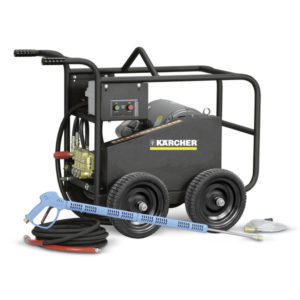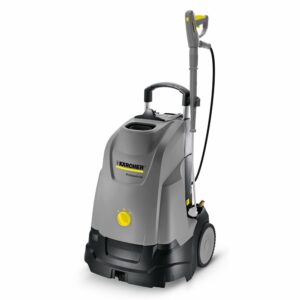How to Clean a Cement Patio

Michael Adeniran is the CEO of Pressure King Inc. He has been dealing in commercial cleaning equipment for many years. He is one of the leading specialists and experts in commercial cleaning products.
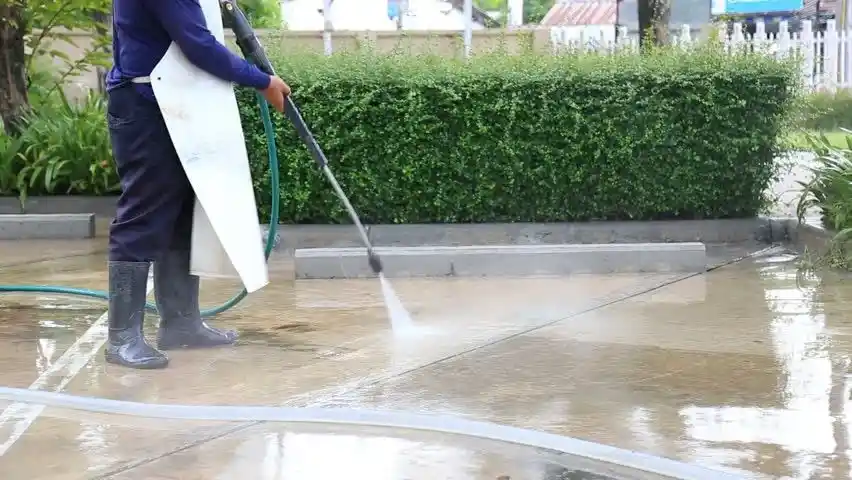
Your patio out of cement is not merely a piece of concrete slab, but an outdoor living room of your residence. If it is used for barbecues, quiet coffee mornings, or for entertaining the guests, keeping it clean for looks and wear is necessary. With time, your cement patio gets dirty, filled with mold, algae, and tough stains that not only look ugly but dangerous. Periodic care and the correct method of keeping patio surfaces clean ensure your space is safe, warm, and durable. How to clean cement patio?
In this guide, we will discuss the most effective methods, tools, and products, such as the best concrete cleaner solutions for the task of cleaning stained concrete, removing mildew, and maintaining a fresh look around the year. From the lightest form of cleaning to power scrubbing and even deep-down stains treatment, you’ll find everything there is to know about the proper cleaning of concrete patio surfaces.
Preparing Your Patio for Cleaning
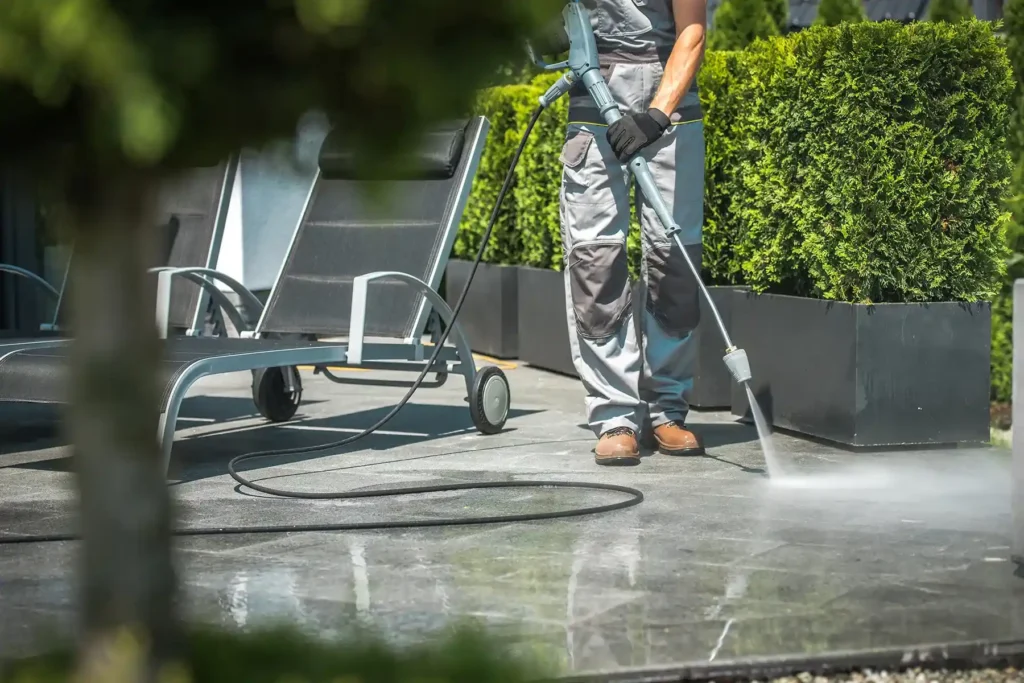
But before you start getting down to deep cleaning concrete floors, it is a must to prepare your patio properly. This means better results and avoiding unnecessary damage to your surfaces or plants around.
1. Remove Furniture and Planters
First, remove all your movable patio furniture, planters, decorations, and grills from the patio. This will give you complete access to all places and protect from staining or damaging your belongings by moisture.
2. Sweep Debris and Loose Dirt
Use a broom or outdoor blower to dispose of dust, dirt and debris. It is a necessary step before using any concrete cleaner, as debris may hinder the cleaning process.
3. Protect Nearby Plants and Lawn
Use plastic sheeting or tarps to cover fields, plants and gardens beside the patio. Some garage floor cleaners or patio solutions may have chemicals that can have negative effects on plants.
4. Check for Cracks and Damage
Check your cement for any form of crack, pitting, or flaking. Avoid using high-pressure techniques such as pressure washers for compromised areas since this may make the problem even worse.
5. Pre-Wet the Surface
Sprinkling water gently on the concrete helps it avoid absorbing cleaner too fast. This makes your scrubbing of stained concrete more effective and spread out appropriately.
Choosing the Right Concrete Cleaner
Grime and stains vary, which is the reason finding the appropriate cleaner for your concrete is very important. Whether it’s mildew or motor oil, you will find a cleaner that is made for that specific problem.
1. pH-Neutral Cleaners: These gentle pH-neutral cleaners are good for everyday use because they won’t hurt sealed surfaces. These cleaners won’t remove any coatings or make the concrete look dull.
2. Degreasers for Oil and Grease: Degreasers will help you get rid of oil from garage floors or patios much more efficiently. Such degreasers eliminate oil and grease stains quite fast.
3. Enzymatic Cleaners for Organic Stains: Degreasers will help you get rid of oil from garage floors or patios much more efficiently. Such degreasers eliminate oil and grease stains quite fast.
4. Mold and Mildew Remover: Mold and mildew may become difficult problems if ignored. Pick cleaners that have been made to handle stains from mold or mildew on concrete.
5. Eco-Friendly Options: If you are worried about the safety of your pets or plants, eco-friendly concrete cleaners are made with ingredients that are both safe and environmentally friendly.
Cleaning Methods for General Maintenance
If you clean your garage floor and patio often, stains and damage won’t build up. Below are a few cleaning methods you can use for different amounts of grime.
1. Soap and Water Scrub
Dish soap and warm water in a bucket are great for getting rid of light dirt and dust. Take a push broom or scrub brush and use its stiff bristles to work the soap into the concrete. Clean the area well by using a garden hose.
2. Vinegar and Baking Soda
To get rid of small patio stains on concrete, first heap baking soda on the stain and mist it with white vinegar. Let the baking soda and vinegar sit for 10 to 15 minutes before you start scrubbing and rinsing.
3. Power Washing
A power washer should be used when there is a lot of grime. It does a great job on cleaning patio concrete. Make sure you don’t use too high pressure, or the concrete surface might be harmed.
4. Spot-Treating Stains
Put the concrete cleaner you picked onto the stained places, let it stay for 10-20 minutes (or as the instructions say), scrub with a brush, and rinse it off.
5. Rinse and Dry
Make sure you rinse the whole patio using a hose or pressure washer so any cleaner or loose dirt is removed. Let the concrete patio dry fully before you look at the results.
Step-by-Step – How To Clean Cement Patio with Pressure Washer
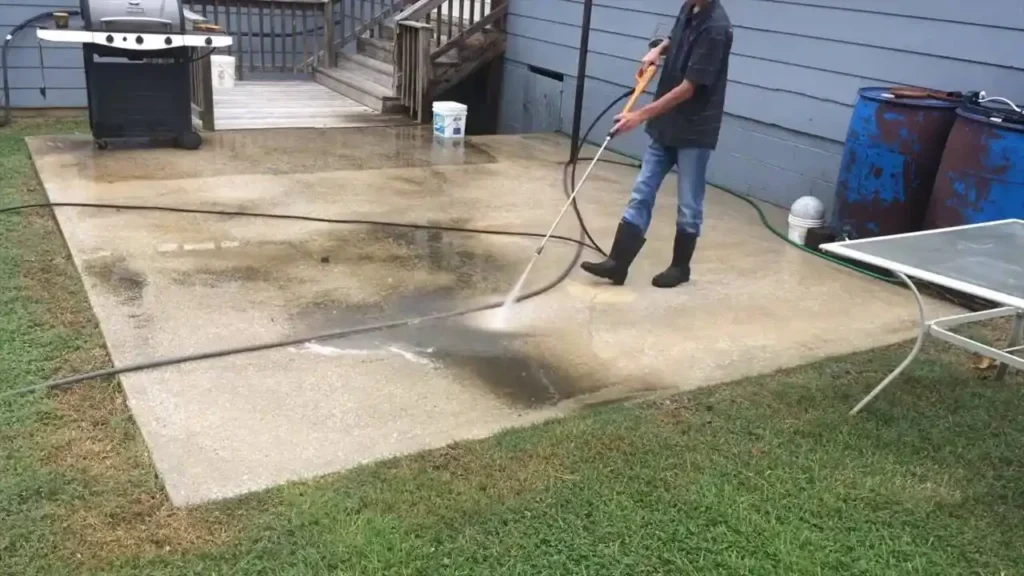
Cleaning a concrete floor with a pressure washer may seem straightforward, but there’s a process to follow if you want professional results. Let’s get into a step-by-step process to tackle the job efficiently—from surface prep and stain treatment to using the correct pressure and rinsing properly.
Step 1: Clear and Sweep the Area
Remove furniture, cars, tools, or anything that can be moved from your concrete surface. Wipe the yard to divert loose gravel and soil, leaves out of the space. Go this way and prepare your surface for deeper crushing action, apart from keeping the washer.
Step 2: Pre-Treat Stains with a Degreaser
In case of oil, grease, or chemical spots: Spray concrete degreaser in these places. Let it sit for 10–15 minutes to help dissolve the grime. Discreet scrub cleanliness with a stiff brush.
Step 3: Connect and Prep the Pressure Washer
First, attach your garden hose, and make sure you have a reliable water source on the other end. Select a wide spray nozzle (ideal for 15°-25° angle surround concrete application and test some of that pressure out in a small, inconspicuous spot.
Step 4: Pressure Wash the Surface
Keep the wand 12–18 inches from the surface. Sweep in a straight line from one end to the other, passing each pass slightly overlapping the last so no streaks can occur. In too heavy areas, work slower or twice as slow, passing it over.
Step 5: Rinse and Let Dry
Wipe the concrete with clean water post cleaning to remove the deposits. Let it completely dry before putting things back or sealing.
Save time, effort, and water with our high-performance washers. With adjustable settings and rugged design, our washers make even the toughest jobs feel effortless.
How to Clean Specific Cement Patio Stains
Different stains require unique treatment strategies. Here’s how to handle some of the most common issues seen on cement patios:
1. Oil and Grease Stains: If you’re wondering how to remove oil from garage floor areas or patios, apply a degreaser or an absorbent like kitty litter to fresh stains. For older stains, scrub with a heavy-duty degreaser garage floor cleaner.
2. Rust Stains: Use a commercial rust remover or oxalic acid-based cleaner. Avoid using bleach, which can react poorly with metal stains.
3. Mold and Mildew: For cleaning stained concrete with mold or mildew, use a mold remover or a diluted bleach solution (1:10 bleach to water). Scrub thoroughly and rinse well.
4. Paint and Sealer Spills: Use a paint stripper formulated for concrete. Follow instructions carefully, and avoid spreading the paint during cleaning.
5. Efflorescence (White Powdery Residue): This is caused by salt deposits rising to the surface. Scrub with a stiff brush and water or use a specialized cleaner for efflorescence.
Cleaning Different Types of Cement Patio Finishes
Just like garage floors, cement patios come in different finishes, each requiring a tailored approach.
1. Brushed or Broom-Finished Concrete
This is the most common and easiest to clean. Regular garage floor cleaning methods work well here, including scrubbing and light pressure washing.
2. Stamped Concrete
Be careful with aggressive cleaners and pressure settings. Use a mild concrete cleaner and soft-bristle brush to preserve the design.
3. Stained Concrete
Stained surfaces need pH-neutral cleaners to avoid altering the coloration. Avoid using vinegar or acidic products.
4. Sealed Concrete
Use non-abrasive cleaners and avoid power washing unless necessary. Reseal annually after thorough cleaning concrete floors.
5. Exposed Aggregate Concrete
This textured finish benefits from pressure washing but requires more frequent maintenance due to its porous nature.
Maintaining a Clean Patio Year-Round
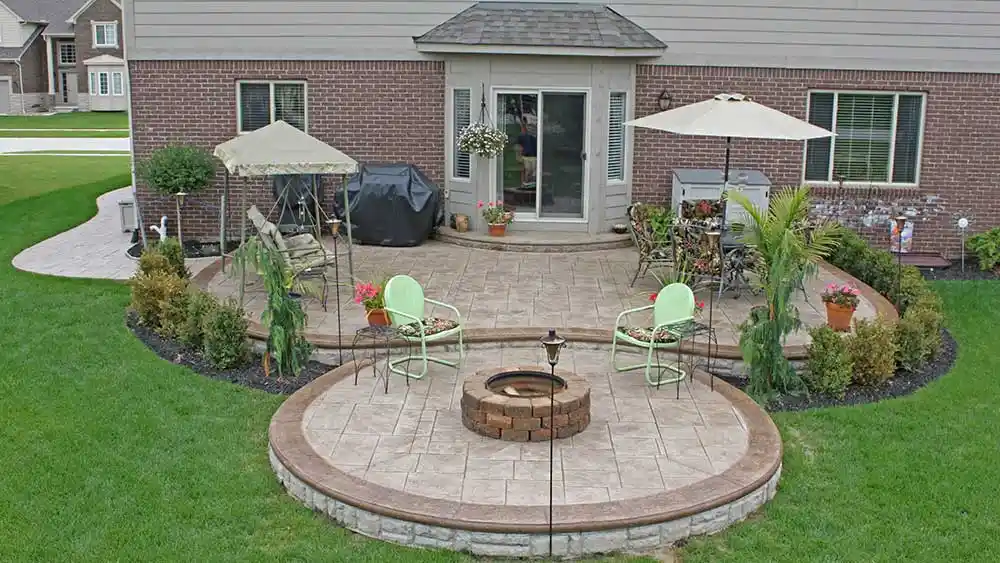
Regular upkeep is the best way to reduce heavy buildup and prolong your patio’s appearance.
- Sweep Weekly: Remove dirt, leaves, and debris to prevent staining.
- Spot Clean Monthly: Tackle small stains as soon as they appear.
- Deep Clean Seasonally: Perform a thorough garage floor cleaning style wash at least twice a year.
- Seal Annually: Apply a concrete sealer to protect from moisture, UV rays, and stains.
- Inspect Frequently: Look for cracks, mold, and wear to treat issues early.
Conclusion: Keep Your Cement Patio Spotless and Inviting
Learning how to clean cement patio areas thoroughly is the key to preserving your outdoor space’s beauty and longevity. Whether you’re dealing with dirt, oil stains, or mildew, the right approach makes a big difference. By using the proper concrete cleaner, maintaining a regular cleaning routine, and understanding your patio’s material, you’ll keep it safe, appealing, and ready for entertaining. Remember: proactive care not only helps with cleaning concrete patio surfaces but also prevents future damage, saving you time and money.
Frequently Asked Questions (FAQs)
What is the best cleaner for a cement patio?
The best concrete cleaner depends on the type of stain. For general cleaning, a pH-neutral cleaner is ideal. For oil, use a degreaser; for mold or mildew, use a mold remover or diluted bleach solution.
How do you clean a concrete patio without a pressure washer?
Mix warm water and dish soap in a bucket, then scrub the surface with a stiff brush. For tougher stains, use baking soda and vinegar. Rinse with a hose and let it dry.
What is the most effective way to clean concrete?
The most effective way is using a concrete cleaner suited for your stain type, followed by scrubbing or power washing. Regular sweeping and sealing also help maintain clean surfaces.
Will vinegar clean the concrete patio?
Yes, vinegar can help with light stains or mildew. Combine with baking soda for better results. However, avoid using vinegar on stained or sealed concrete to prevent damage.
How to make stained concrete look new again?
Clean with a gentle concrete cleaner, scrub thoroughly, and rinse. For deeper stains, use a stain-specific product. Reapplying a concrete sealer can also restore the shine and color.
How to clean cement floors?
Sweep thoroughly, then mop with warm water and mild detergent or a pH-neutral concrete cleaner. Spot-clean stains and rinse well. For indoor cement floors, avoid oversaturating with water.
How to clean concrete without a pressure washer?
Use a stiff brush with soap and water, or apply a cleaner based on the type of stain. Let it sit for 10–15 minutes before scrubbing. Rinse with a garden hose for best results.







